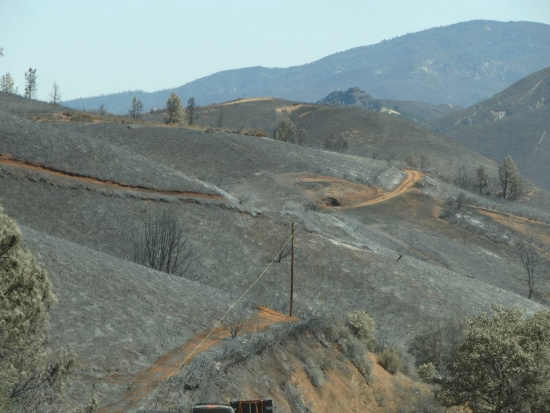
Aftermath of Wye and Walker Fires in Lake Co.
The Wye and Walker fires that blazed across Lake Co. left a swath of devastation behind —almost 8000 blackened acres. LaDonna Auxier, a SoHum resident caught some of the awful residue on camera. Two structures and one outbuilding were destroyed. Two more damaged. Hwy 20 was shut down and the landscape has changed.
Auxier says, “It was really crazy how far it went, from the [Highway] 20/53 split, to the [Highway]16/Rumsy/Cache Creek turn off. I saw a huge bull Elk dead on the side of the road. I wonder what the loss to Elk, deer and cattle were…. Horrible thinking of them running down to the highway to get away from the flames.”
Several residents expressed the same concern for wildlife and other domestic animals. Below the photos is a revised version of a piece I wrote a few years ago about wild creatures and wildfires.
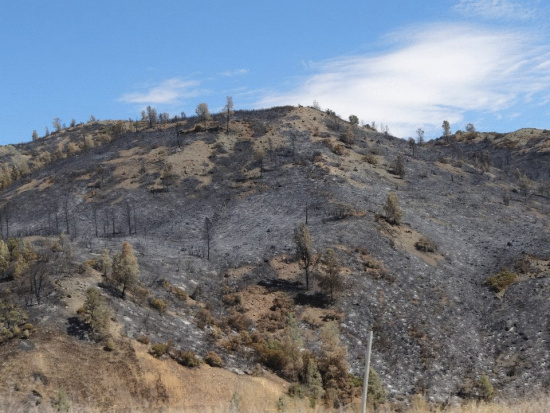
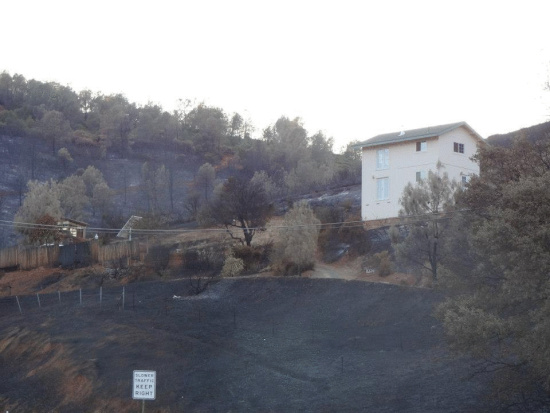
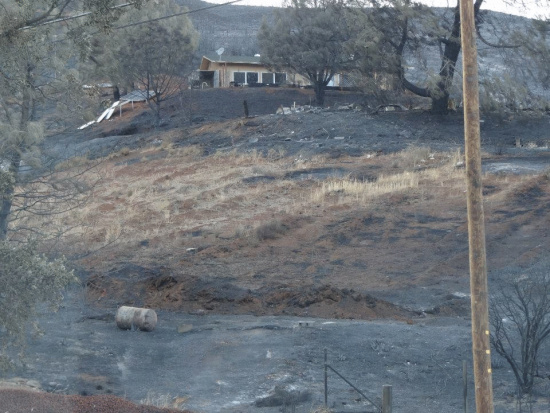
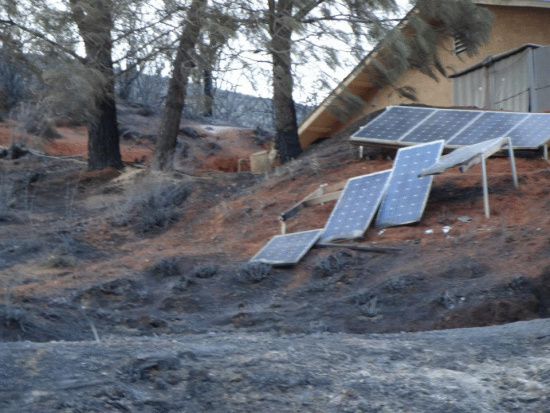
Do wildfires still burning throughout California pose a serious threat to the animals that live in those lands?
The image of a frightened Bambi racing through flaming forestlands has been seared into our hearts as children. Smoky the Bear comic books handed out by forest rangers in classrooms across the nation have just added heat to the wound . Yet, when I spoke to Greg Giusti, UC Forest Adviser for Mendocino and Lake Counties, he said, Most fires are small and slow. They creep “along allowing many species of wildlife such as deer and bear to walk away… Other species like salamanders escape into gopher burrows.” Even lizards can slip under logs or rocks and are likely to be mostly safe from these lightning fires. “Nesting season has mostly passed” this time of year, Giusti said, “and birds just fly away.”
“Research to date indicates that light to moderate-intensity fire in California oak woodlands probably has little adverse impact on wildlife,” Bill Tietje, a Natural Resource Specialist from San Luis Obispo, said in 2002. “Overall, it can be beneficial by reducing resource competition from exotic annual grasses, stimulating shrub and tree vigor and, ultimately, habitat rejuvenation.”
When reached for comment about the 2008 California fires, Tietje said that fire suppression efforts “over the last 50 years or so have allowed fuel loads to be built up.” Many blazes now are much hotter and faster moving than in the past. Tietje says, “…Mammals have evolved to evade frequent and low intensity fires.” However, more recent conflagrations can burn quickly and intensely. For instance, the 1994 fire near Hwy 41 which charred approximately 50,000 acres in San Luis Obispo County, burned so hot and fast that forest service workers observed quail “becoming disorientated” and flying into the fire. After the disaster, deer and mountain lions as well as smaller creatures such as rabbits were found burned to death.
Here is a link to YouTube video about wildlife injured by fires. The video doesn’t allow embedding but it does show some of the terrible consequences of these kind of blazes (please be aware some images are quite graphic—please use discretion in viewing with children). If injured animals are found in the Mendocino area due to the current Pass Fire near Covelo, the only permitted organization in the Mendocino area is Woodlands Wildlife Rescue (see here for names and phone numbers of ones in other areas including Humboldt). During the Mendocino Lightning fires in 2008, the Willits Wildlife center had received no calls directly attributable to the fires other than a few about “grounded hawks.” Apparently the raptors (picture at right is from a stock photo) can become disoriented by the smoke and need to land. They sometimes will stay for several days if undisturbed. They are probably not injured just suffering from the smoke, according to a worker at the Rescue place. If left alone, they eventually recover and fly away.
does show some of the terrible consequences of these kind of blazes (please be aware some images are quite graphic—please use discretion in viewing with children). If injured animals are found in the Mendocino area due to the current Pass Fire near Covelo, the only permitted organization in the Mendocino area is Woodlands Wildlife Rescue (see here for names and phone numbers of ones in other areas including Humboldt). During the Mendocino Lightning fires in 2008, the Willits Wildlife center had received no calls directly attributable to the fires other than a few about “grounded hawks.” Apparently the raptors (picture at right is from a stock photo) can become disoriented by the smoke and need to land. They sometimes will stay for several days if undisturbed. They are probably not injured just suffering from the smoke, according to a worker at the Rescue place. If left alone, they eventually recover and fly away.
Willits Wildlife Rescue warned that wild animals (even those injured) can and do strike out at people. Use discretion and contact the center nearest you for help and advice before approaching the animals. In fact, not all animals can be saved. Giusti warns “Nature is a tough system. Some animals do die…Deciding whether or not to rescue is a personal choice.”
However, Bill Tietje says that the immediate deaths and injuries are not the only problem for wild animals. After the fires, habitat will often be destroyed and the creatures must relocate to areas which are already inhabited by other creatures. This lessens their overall chance of survival. Unfamiliar with an area, they can more easily be found and killed by predators. Furthermore, the stress of the fire and the consequent relocation can make them more subject to illness….
However, most creatures will survive. Greg Giusti notes that big mammals can endure for awhile. Bears, for example, have so much body mass that a loss of 10 to 15 pounds isn’t going to kill them. Bears also cover a lot of ground and may choose to move into nearby human territory. “It is always good to be extra careful…It is not good for any wild animal to get too comfortable around humans. This almost always leads to the demise of the animal.” He goes on to recommend that pet food be locked up at night and fallen fruit should be picked up quickly in orchards. With slow fires like the Mendocino Lightning fires, some trees and bushes in fire damaged areas will still produce acorns and berries to feed animals that return to the area eventually.
In fact, Bill Tietje says that, over the long run, wildlife will benefit by the natural stimulation the land receives from fire. There will be new plant growth and a return of animals to the fire lands. Greg Giusti says, “Over the years, I have seen a number of photos of deer walking through a burned area while it was still smoking.”
CLICK TO MANAGE